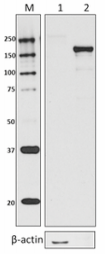- Clone
- NT73 (See other available formats)
- Regulatory Status
- RUO
- Other Names
- RNA pol beta prime, rpoC, tabB, DNA-directed RNA polymerase subunit beta prime, RNAP subunit beta prime, RNA polymerase subunit beta prime, Transcriptase subunit beta prime
- Isotype
- Mouse IgG1
- Ave. Rating
- Submit a Review
- Product Citations
- publications

-

Total lysates (15 µg protein) from HeLa (lane 1) and E. coli BL21 (lane 2) cells were resolved by electrophoresis (4-12% Bis-Tris gel), transferred to nitrocellulose, and probed with 1:1000 diluted (1 µg/mL) purified anti-E. coli RNA Polymerase β Prime antibody (clone NT73). Proteins were visualized using an HRP goat anti-mouse-IgG secondary antibody (clone Poly4053, Cat. No. 405306). 1:2000 dilution of Direct-Blot™ HRP anti-β-actin antibody (clone 2F1-1, Cat. No. 643807) was used as a loading control (lower). Lane M: Molecular weight ladder. -

Total cell lysate from Hela cells (lane 1) and E Coli. Strain DH5α (lane 2) (15 µg protein for each) were resolved by 4-12% Bis-Tris gel electrophoresis, transferred to nitrocellulose, and probed with a 1:1000 dilution (1 µg/mL) of purified anti-E. coli RNA Polymerase β Prime antibody (clone NT73) (upper blot). Proteins were visualized using chemiluminescence detection after incubation with 1:3000 dilution of HRP conjugated anti-mouse-IgG secondary antibody for anti-E. coli RNA Polymerase β Prime Antibody (upper blot). Ponceau S staining (lower blot) was used as loading control. Lane M: Molecular Weight Marker
| Cat # | Size | Price | Quantity Check Availability | Save | ||
|---|---|---|---|---|---|---|
| 662904 | 100 µg | 323 CHF | ||||
RNA polymerase (RNAP or RNApol) is an enzyme that produces primary transcript RNA. The β subunit is the second-largest subunit, and is encoded by the rpoB gene. RNA polymerase β is a subunit which, along wtih α (rpoC), limits core polymerase expression.
Product DetailsProduct Details
- Verified Reactivity
- E. coli
- Reported Reactivity
- Other species
- Antibody Type
- Monoclonal
- Host Species
- Mouse
- Immunogen
- 1295-1417 (SLAELLNAGLGGS) of the E. coli RNA polymerase β subunit.
- Formulation
- Phosphate-buffered solution, pH 7.2.
- Preparation
- The antibody was purified by affinity chromatography.
- Concentration
- 1.0 mg/ml
- Storage & Handling
- The antibody solution should be stored undiluted between 2°C and 8°C.
- Application
-
WB - Quality tested
ELISA, IP - Reported in the literature, not verified in house - Recommended Usage
-
Each lot of this antibody is quality control tested by Western blotting. For Western blotting, the suggested use of this reagent is 0.25 - 1.0 µg per ml. It is recommended that the reagent be titrated for optimal performance for each application.
- Application Notes
-
Clone NT73 is extremely useful for purifying holoenzymes from enterics. It does not cross-react with Mycobacterial smegmatis RNAP. This antibody is used for purifying Softag 1 epitope tagged protein expressed in eukaryotic systems. Clone NT73 recognizes epitope 1295-1417 (SLAELLNAGLGGS).
Additional reported applications (for the relevant formats) include: immunoprecipitation. -
Application References
(PubMed link indicates BioLegend citation) -
- Thompson NE, et al. 1992. Biochemistry 31:7003.
- Thompson NE, et al. 2003. Anal. Biochem. 323:171.
- RRID
-
AB_2566242 (BioLegend Cat. No. 662904)
Antigen Details
- Structure
- 1252 amino acids with a predicted molecular weight of approximately 150 kD.
- Distribution
-
Bacteria
- Function
- Transcriptional regulator in bacteria.
- Biology Area
- Cell Biology, Transcription Factors
- Molecular Family
- Nuclear Markers
- Antigen References
-
1. Thompson NE, et al. 1992. Biochemistry 31:7003.
2. Hurwitz J, et al. 2005. J. Biol. Chem. 280:42477.
3. Hirata A, et al. 2008. Nature 451:851. - Gene ID
- 948488 View all products for this Gene ID
- UniProt
- View information about RNA Polymerase beta Prime on UniProt.org
Related Pages & Pathways
Pages
Related FAQs
Other Formats
View All RNA Polymerase β Prime Reagents Request Custom Conjugation| Description | Clone | Applications |
|---|---|---|
| Anti-E. coli RNA Polymerase ImmunoAffinity Resin | NT73 | IP |
| Purified anti-E. coli RNA Polymerase β Prime | NT73 | WB,ELISA,IP |
Compare Data Across All Formats
This data display is provided for general comparisons between formats.
Your actual data may vary due to variations in samples, target cells, instruments and their settings, staining conditions, and other factors.
If you need assistance with selecting the best format contact our expert technical support team.
-
Anti-E. coli RNA Polymerase ImmunoAffinity Resin
-
Purified anti-E. coli RNA Polymerase β Prime

Total lysates (15 µg protein) from HeLa (lane 1) and E. coli... 
Total cell lysate from Hela cells (lane 1) and E Coli...
 Login / Register
Login / Register 












Follow Us